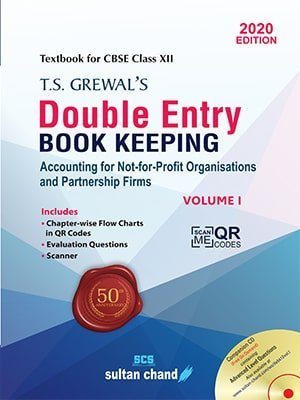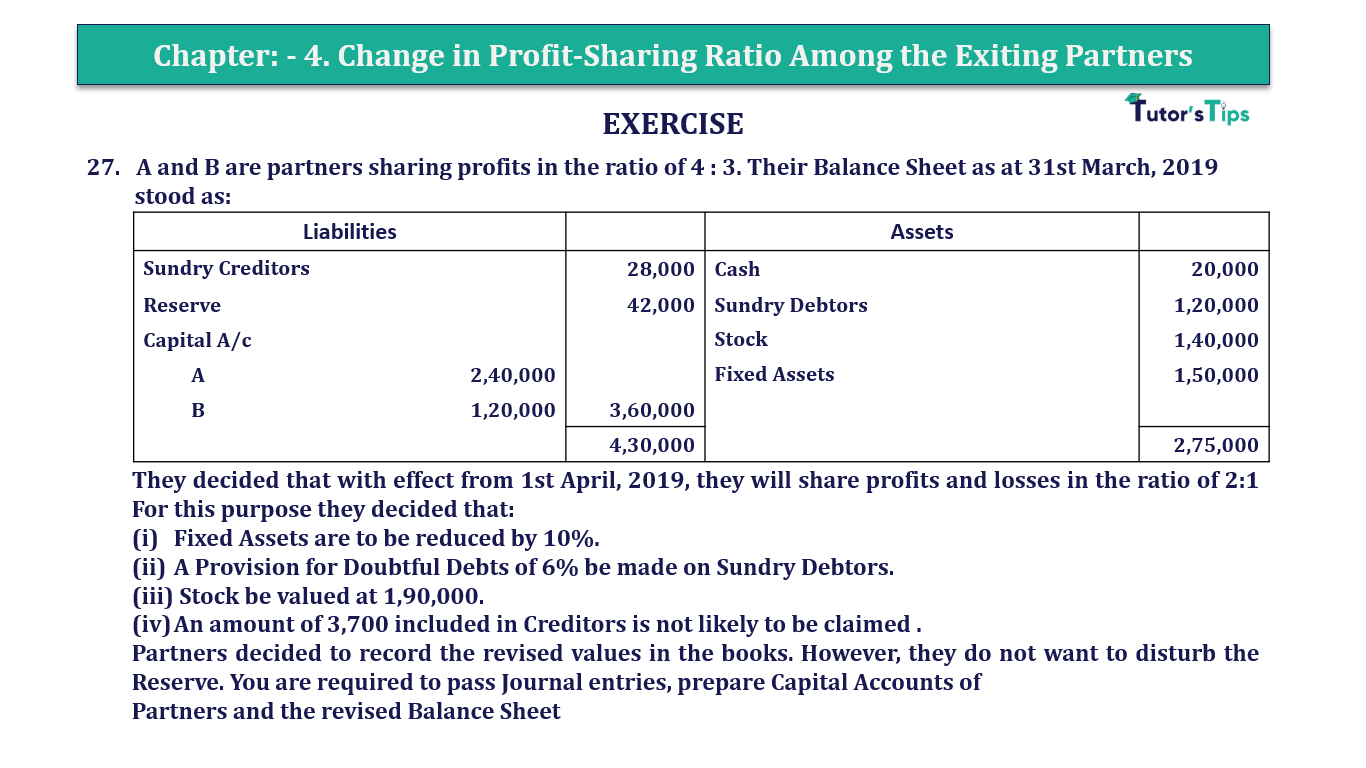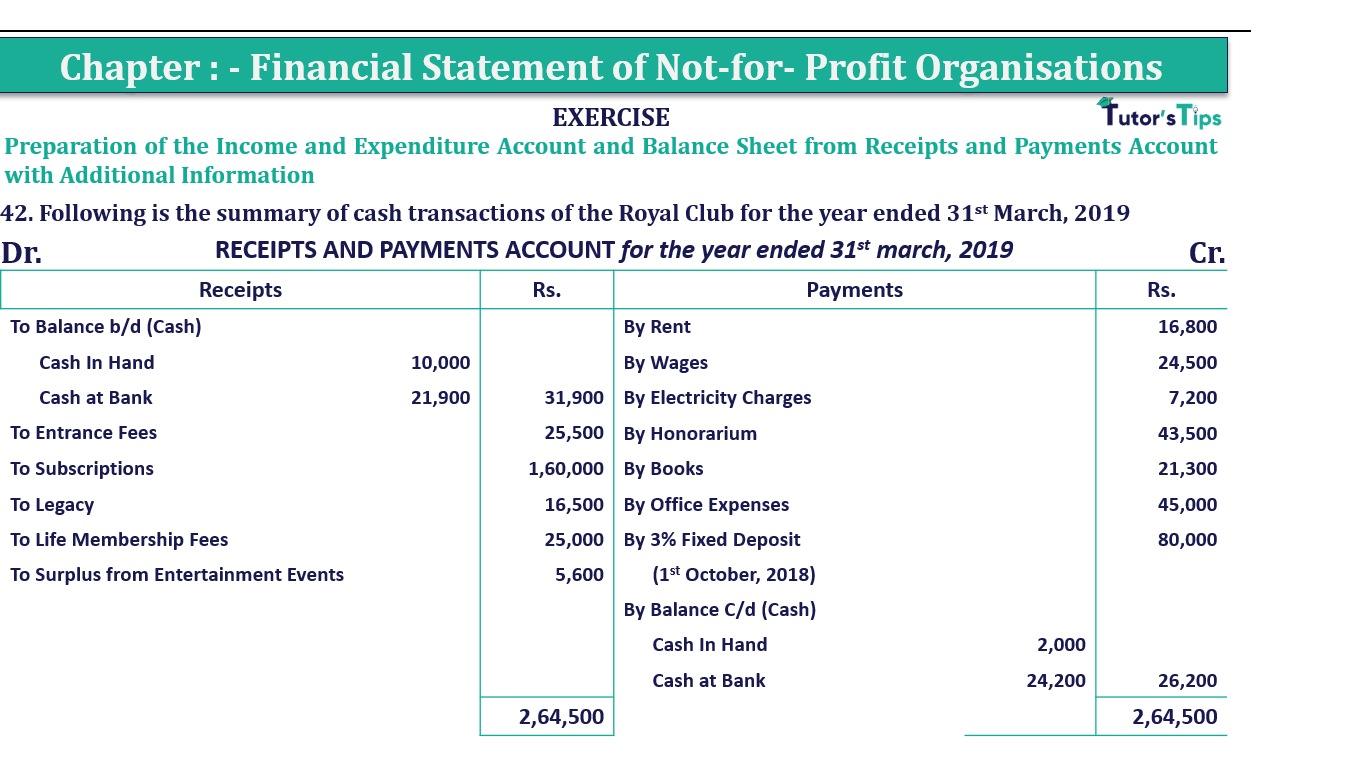Question 27 Chapter 4 of +2-A
Table of Contents
27. A and B are partners sharing profits in the ratio of 4 : 3. Their Balance Sheet as at 31st March, 2019 stood as:
| Liabilities | Assets | |||
| Sundry Creditors | 28,000 | Cash | 20,000 | |
| Reserve | 42,000 | Sundry Debtors | 1,20,000 | |
| Capital A/c | Stock | 1,40,000 | ||
| A | 2,40,000 | Fixed Assets | 1,50,000 | |
| B | 1,20,000 | 3,60,000 | ||
| 4,30,000 | 2,75,000 |
They decided that with effect from 1st April, 2019, they will share profits and losses in the ratio of 2:1 For this purpose they decided that:
- Fixed Assets are to be reduced by 10%.
- A Provision for Doubtful Debts of 6% be made on Sundry Debtors.
Stock be valued at 1,90,000. - An amount of 3,700 included in Creditors is not likely to be claimed .
Partners decided to record the revised values in the books. However, they do not want to disturb the Reserve. You are required to pass Journal entries, prepare Capital Accounts of Partners and the revised Balance Sheet
The solution of Question 27 Chapter 4 of +2-A
| In the Books of _______________ | |||||
| Date | Particulars |
L.F. | Debit | Credit | |
| 2019 | |||||
| A’s Capital A/c | Dr | 4,000 | |||
| To B’s Capital A/c*3 | 4,000 | ||||
| (Being adjustment make for the revaluation of assets and liabilities) | |||||
| Revaluation A/c |
||||
| Particulars |
Amount | Particulars | Amount | |
| To Fixed Assets A/c | 15,000 | By Stock A/c | 50,000 | |
| To Provision for Doubtful Debts A/c 1, 20, 000 × 6 | 7,200 | By Creditors A/c | 3,700 | |
| To Profit on Revaluation*2 | 31,500 | |||
| A | 18,000 | |||
| B | 13,500 | |||
| 53,700 | 53,700 | |||
| Partners’ Capital Accounts for the year ended 31st March, 2019 |
||||||
| Particulars |
A | B | Particulars |
A | B | |
| To B’s Capital A/c | 4,000 | By Balance B/d | 2,40,000 | 1,20,000 | ||
| By Revaluation A/c | 18,000 | 13,500 | ||||
| By A’s Capital A/c | – | 4,000 | ||||
| To Balance c/d |
2,54,000 |
1,37,500 |
||||
| 2,58,000 | 1,37,500 |
2,58,000 |
1,37,500 |
|||
| Balance Sheet as on 01st April, 2019 |
|||||
| Particulars |
Amount | Particulars |
Amount | ||
| Sunday Creditors | 28,000 | Cash | 20,000 | ||
| 3,700 | 24,300 | Sundry Debtors | 1,20,000 | ||
| General Reserve | 42,000 | Less: Provision for Doubtful Debts. | 7, 200 | 1,12,800 | |
| Capital A/c | 44,000 | Stock | 1,90,000 | ||
| A | 2,54,000 | 20,000 | Fixed Assets (1,50,000– 15,000) | 1,35,000 | |
| B | 1,37,500 | ||||
| 4,57,800 | 4,57,800 | ||||
Working Note :
| Old Ratio of X, & Y | = | 4 : 3 |
| New Ratio of X, & Y | = | 2 : 1 |
Calculate the Sacrificing or Gaining Ratio of Partners
Sacrificing or Gaining Ratio = Old Ratio – New Ratio
Advertisement-X
| A’s Share Sacrificing/Gaining | = | 4 | – | 2 |
| 7 | 3 |
| = | 12 – 14 | |
| 21 |
| = | -3 | (Gain) |
|
| 21 |
| B’s Share Sacrificing/Gaining | = | 3 | – | 1 |
| 7 | 3 |
| = | 9 – 7 | |
| 21 |
| = | 2 | (Sacrifice) |
|
| 21 |
WN *1 Adjustment of General Reserve: –
| Amount to be Debited to A’s Capital | = | 42,000 | X | 2 |
| 21 | ||||
| = | 4,000 |
| Amount to be Credited to B’s Capital | = | 42,000 | X | 2 |
| 1 | ||||
| = | 4,000 |
Advertisement-Y
WN *2 Adjustment of Profit on revaluation : –
| Amount to be Credited to A’s Capital | = | 31,500 | X | 4 |
| 7 | ||||
| = | 18,000 |
| Amount to be Credited to B’s Capital | = | 31,500 | X | 3 |
| 7 | ||||
| = | 13,500 |
T.S. Grewal’s Double Entry Book Keeping +2 (Vol. I: Accounting for Not-for-Profit Organizations and Partnership Firms)
- Chapter No. 1 – Financial Statement of Not-For-Profit Organisations
- Chapter No. 2 – Accounting for Partnership Firms – Fundamentals
- Chapter No. 3 – Goodwill: Nature and Valuation
- Chapter No. 4 – Change in Profit-Sharing Ratio Among the Existing Partners
- Chapter No. 5 – Admission of a Partner
- Chapter No. 6 – Retirement/Death of a Partner
- Chapter No. 7 – Dissolution of a Partnership Firm
T.S. Grewal’s Double Entry Book Keeping (Vol. II: Accounting for Companies)
- Chapter No. 8 – Company Accounts – Accounting for Share Capital
- Chapter No. 9 – Company Accounts – Issue of Debentures
- Chapter No. 10 – Redemption of Debentures
T.S. Grewal’s Double Entry Book Keeping (Vol. II: Accounting for Companies)
- Chapter No. 1 – Financial Statements of a Company
- Chapter No. 2 – Financial Statement Analysis
- Chapter No. 3 – Tools of Financial Statement Analysis – Comparative Statements and Common- Size Statements
- Chapter No. 4 – Accounting Ratios
- Chapter No. 5 – Cash Flow Statement
Check out T.S. Grewal +2 Book 2020@ Official Website of Sultan Chand Publication








Leave a Reply